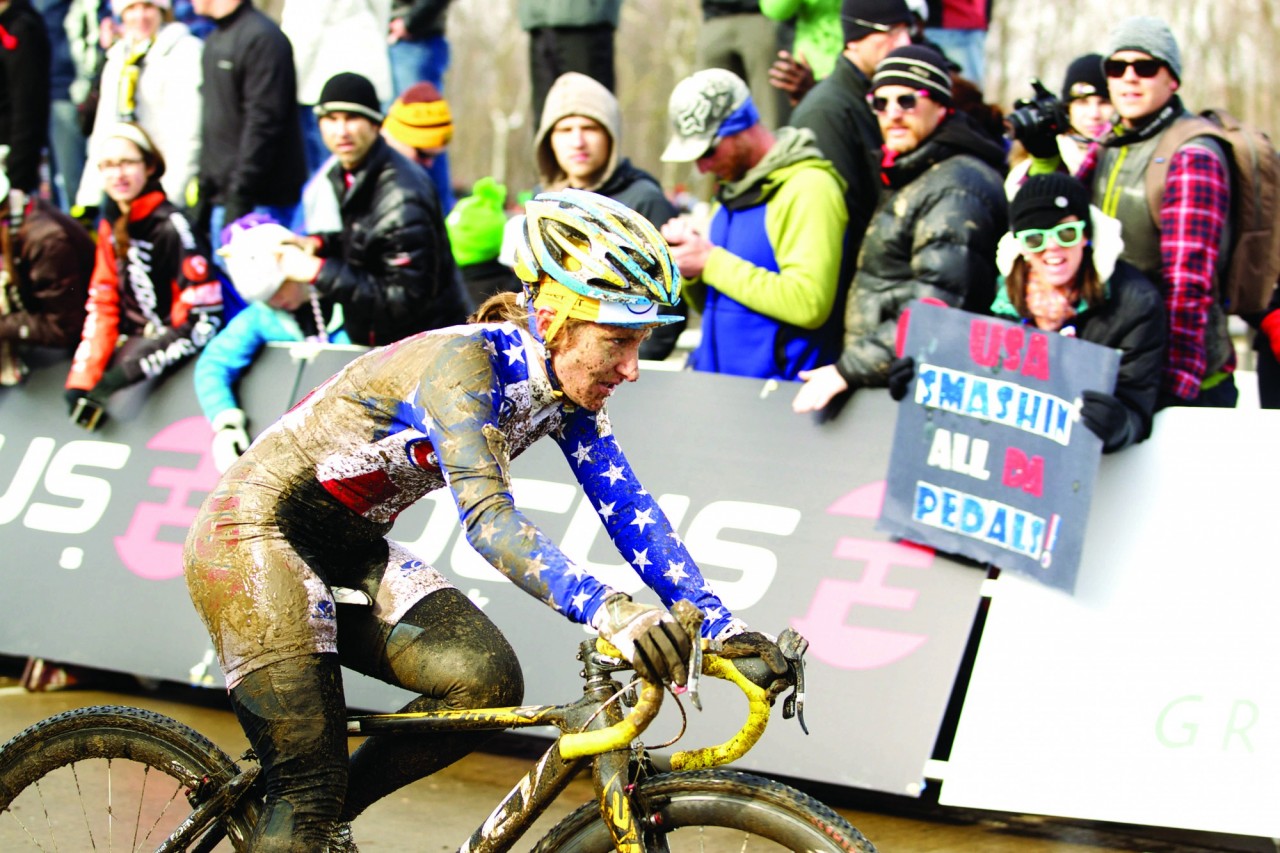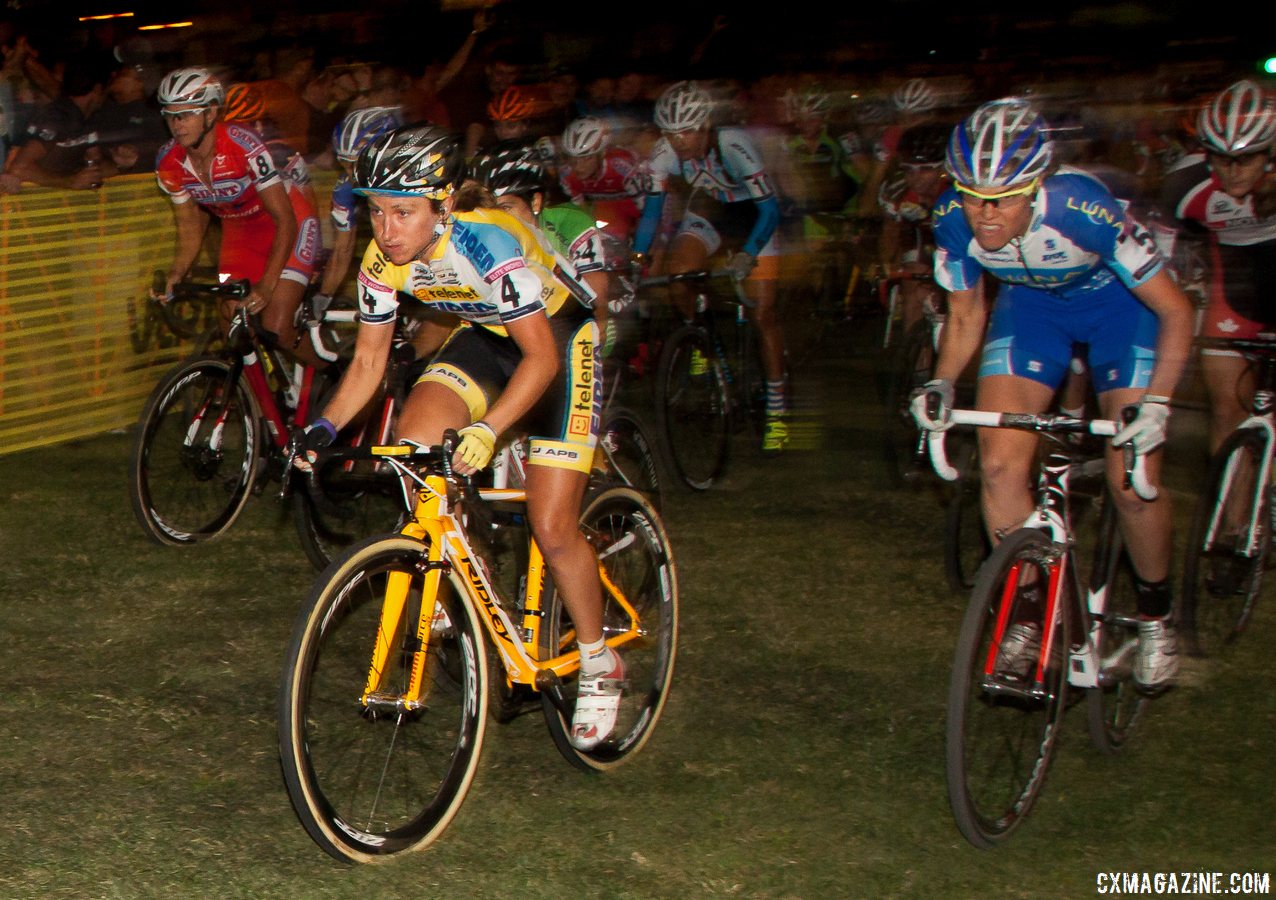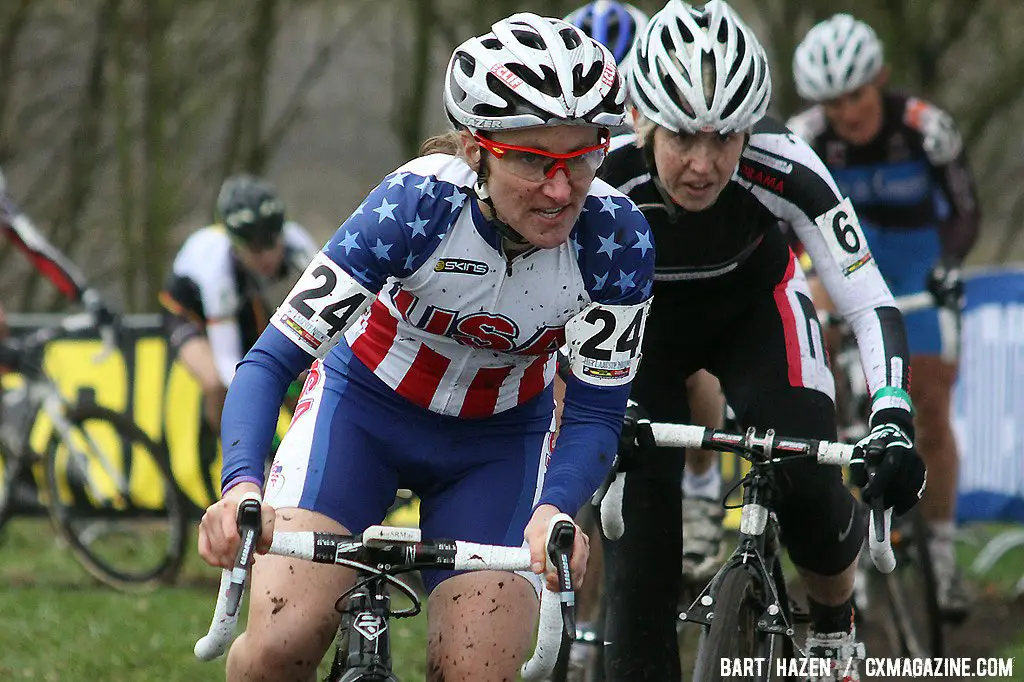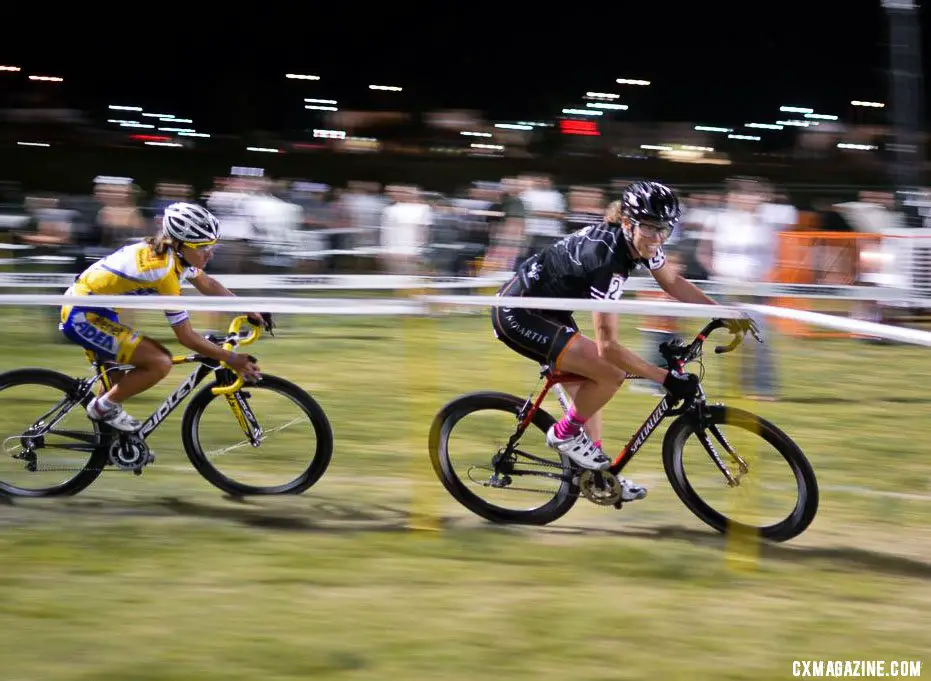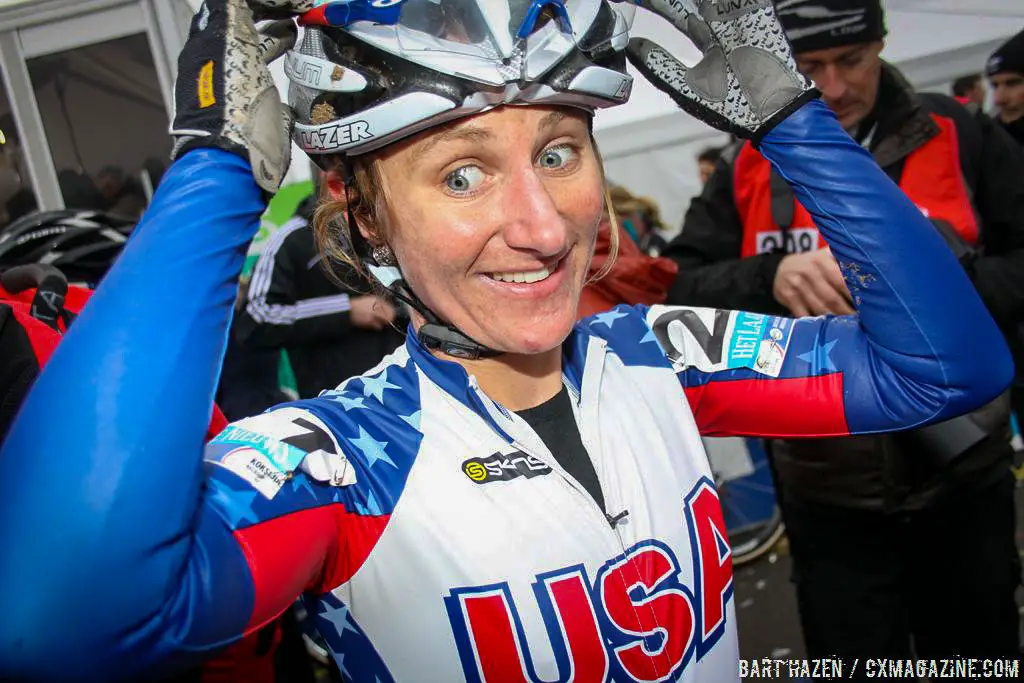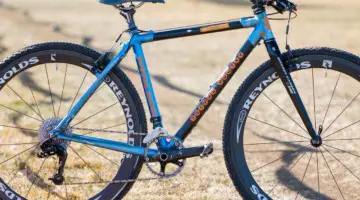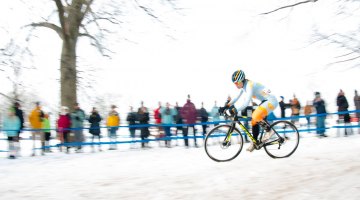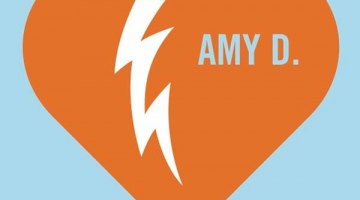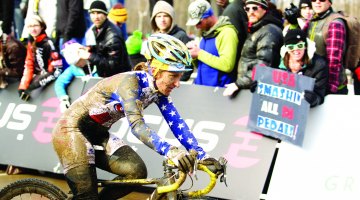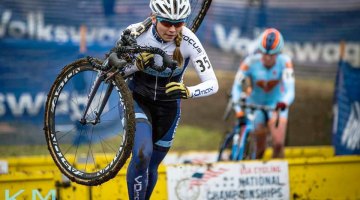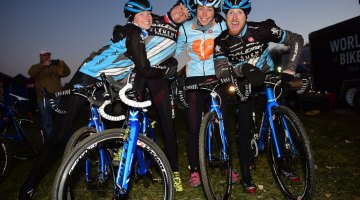In the past week, the cyclocross community was rocked with the greatest tragedy any of us could have conceived of: a young racer was taken from us far before her time. Not only was Amy Dombroski a cyclocross star who had done great things in the sport, but she was also counted a friend by virtually anyone who had the pleasure of meeting her. One commemorative sticker placed on people’s frames last week in Providence read, “Never forget Amy Dombroski’s smile,” a statement that was far more than just a hollow sentiment. Her smile was legendary, and her constant cheerfulness was an inspiration. David Evans did an in-depth profile with a while back. Now, as a tribute, we wanted to share this intimate look into her life in the US and Belgium, and her deep love of racing, with as many people as possible. It’s a lengthy read, but we know it’s worthwhile.
by David Evans
The night before the Hoogerheide World Cup, Amy Dombroski’s dinner started with a 10-inch plate of raw garlic garnished with olive oil and a couple of slices of tomato. The garlic was the main event. It filled the plate and had the pungent oiliness of young garlic that some find a little offensive.
Amy Dombroski is diminutive even by the standards of pro cycling, a sport in which a rider of 80kg is nicknamed ‘The Gorilla.’ She’s noticeably slight, and can tuck her legs beneath herself on a smaller than average-sized dining room chair, which she does for most of our interview.
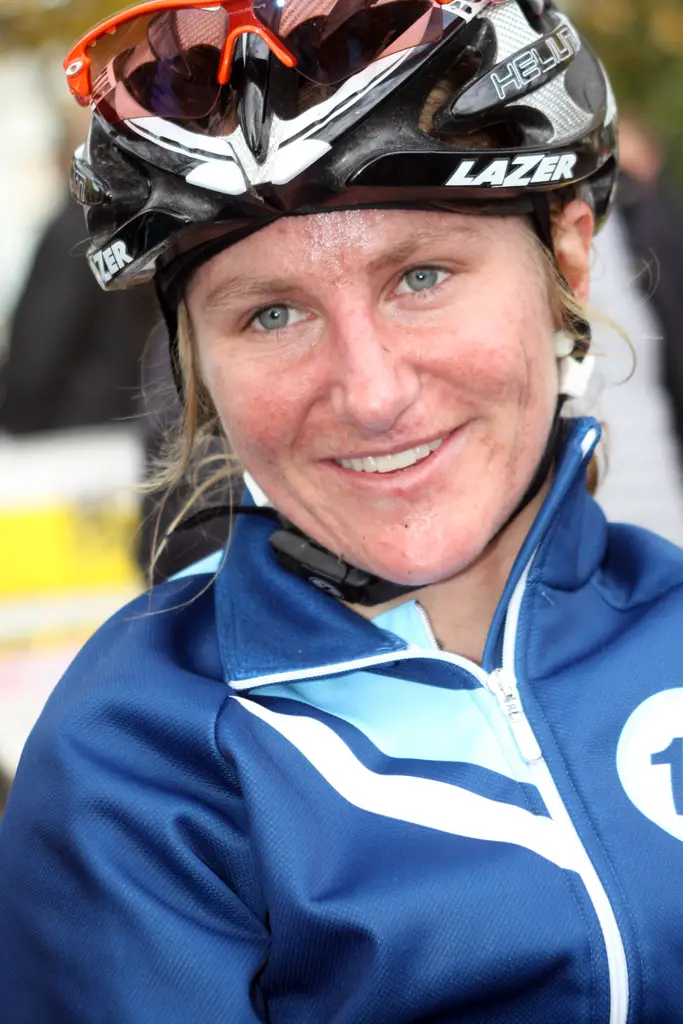
American Amy Dombroski has had an impressive Euro seasaAmerican Amy Dombroski in 2011. © Bart Hazen / Cyclocross Magazineon so far. © Bart Hazen
Amy’s plate was filled with raw garlic because antibiotics are bad for form. A stray piece of bicycle had pierced Amy’s shin in a crash during her previous race, leaving a wound that would have stopped most people walking, never mind finishing the race. Antibiotics must be avoided as they take the edge off your fitness, leave you feeling flat and unresponsive, she says. A deep gash into the shin is also bad for form, but the pain from this can be ignored whereas antibiotic sluggishness cannot, so a heap of raw garlic wins out.
My stream of questions on this garlic—where she’d learned the trick, the taste, why she thought it worthwhile, the odorous side effects, so on—caused no end of mirth in Amy.
“You’re reading too much into this,” she said, “All that happens is I don’t get infected and I smell great. You don’t want to talk about the race?”
The accusation of my reading too much into it was prescient. I now think of a 49kg, 25-year-old American with a heaped spoon of sliced garlic as the ultimate example of why cycling journalists adopt the same misty-eyed and sentimental timbre when it comes to Belgium:
Spend any amount of time in Belgium, and soon certain clichés will ring true. The winters are monotone and affectation-free; the fries are universally excellent; the accents—Flemish and Walloon—are heavily inflected and guttural and make the speaker sound quite like she/he has a minor vendetta against the listener; high-quality chocolate is temptingly and inexpensively available on every horizontal surface—and many vertical—in every bodega; the pop music is mostly electro and relentless and tinny; the beer is plentiful and strong and confusingly diverse.
So the true-ringingness of all these clichés soon deafens us to the subtler tones of Belgium.
Amy Dombroski is one of America’s premier cyclocross talents, and this status is all the more notable since Dombroski has gained it through years of graft and application instead of ‘b’-of-the-bang aptitude alone. What’s more, her sophomore year of life as a Belgian Pro has taught her to set her sights on the next rung of the ladder—World Cup podiums, a top-five ranking, maybe even a win. She’s learning what it takes, and ‘what it takes’ involves the occasional plate of garlic. Belgium is far weirder and far more wonderful than most people ever let on.
It’s the sort of place where a young person would forgo everyday medical advice without hesitation and have in its place a fairly awkward home remedy and, what’s more, no one would find this in any way remarkable. This is no bad thing.
The last race of this year’s UCI Cyclocross World Cup was in Hoogerheide, Holland. Hoogerheide is a small town, about a €25 taxi ride from Bergen Op Zoom. The Belgian border passes diagonally through its north-western district and, as is common practice in the Benelux region, the demarcation between countries is so negligible as to be totally unnoticeable. The town has three well-maintained main streets that stretch away from a roundabout at their base, and all of the streets are filled with the type of road furniture and traffic calming obstacles that make the Spring Classics so barbarous and watch-able. There is a predictable succession of shops, banks, cafes and houses along these streets, all conforming to the same boxy, efficient post-War school of architecture; for really obvious historical reasons most of the architecture in this part of Europe is post-War.
I mention this because there isn’t much else to say about Hoogerheide. Even the most sympathetic of visitors might call it ‘tired’.
I also mention this because it was, as I believe I mentioned above, cold. Further exploration was not advisable. I tried not to leave Hoogerheide’s cafes for any form of journalistic investigation or inquiry unless absolutely required by the most elemental code of professional conduct. This was ill-advised, as the coffee in Hoogerheide is so poor that it made me wonder if I was confusing the Dutch word for ‘coffee’ with one that meant ‘the stuff that comes out of a coffee machine when you forget to change the grinds between two cups of coffee’.
The day before the race the snow on the walkways was doing that really treacherous thing that snow does when it is put under repeated pressure by walkers and takes on a flat gloss and frictionless quality. I fell on my backside several times.
I had arranged to meet Amy Dombroski on the Saturday before the race, when she’d be there to ride the course, experiment with tire pressures, pick racing lines and, it seemed, swaddle herself in every piece of cycling clothing she owned. It was really very cold indeed.
For the last two years Hoogerheide has been a mudfest. The race has been slow and attrition-based, decided by successful visits to the pits and prayers to the patron saint of pinch flats. It was already clear 2013 would be totally different, and that the experience gained in previous editions would be of limited value here.
Thankfully, Amy is of a profession that demands she keeps herself warm, comfortable and unstressed at all times, so after introducing herself behind several layers of balaclavas and thermal face wraps, and possibly noticing the snot frozen to my cheeks, she insisted I wait in a cafe with her mechanic Ignace and two friends, Vic and Emil.
I waited in the café with Ignace, Vic and Emil, and sat passively as they told me how I could pass as Flemish—I can’t—what cycling deities’ successes they are partly/wholly responsible for—Brian Holm, Bart Wellens, themselves, Matt Brammeier—the extent of the Belgian Royal family’s embezzlement and tax avoidance—large—and the top speed of Amy’s motorpacing session, piloted by Emil—60 kph.
When Amy returned she took a coffee—offering Ignace the accompanying sugar and biscuit—and talked shop. “It’s possible to lean into three corners, which is better than I expected.” She specified treads and pressures with her mechanic, counting out the conversion between psi and bar on her fingers. “That caused some problems when I first came here, now I have the conversion charts on a poster on my wall,” she explained, “Instead of, you know, a photo of a hunk.”
Ignace nodded at the end of each sentence, a tilt of the head indicated a request for elaboration. They have only been working together for the past season, and there’s a language barrier to contend with, but their relationship had already developed its own shorthand and conventions. Vic and Emil chipped in with an appreciative “aahh” or “hmmm” when a tactical point was made.
After the coffees, we piled in to Emil’s car for the hour drive home, stopping once so for Vic to relieve himself – notable because Emil braked a little too sharply and Vic had the passenger door open while the car was still going, holding his feet above the moving tarmac like a DS on a wheel change. Vic is in his seventies. Amy, while this was happening, didn’t pause her story.
A history of the subject of this interview: Amy Dombroski races bikes. She’s raced lots of different types of bikes, in many disciplines, for many sponsors. She has the sort of palmarès that has cemented her position as one of the top women in U.S. ’cross, despite being only 25 years old. At any given Belgian ’cross race you will find cars in the carpark older than she is. After persistent podium-bothering, a haul of national U23 titles and minor controversies in the U.S., Amy moved to Belgium. She spent her first season with Crankbrothers Race Club, before signing with a stalwart of the European ’cross scene, Telenet-Fidea.
Amy cites Christine Vardaros as the person who helped her build a home in Belgium, providing contacts for teams, races and housemates. It’s hard to overstate how small a world Belgian cyclocross is, and a rider without contacts is a rider without a chance. “After my first visit to Europe it became really clear that to do well you need to be at home and happy. Not jet-lagged, not based in a hotel room, not homesick.” Anyone looking for evidence for this theory should look no further than Katie Compton’s trials and tribulations in Europe—the finest female American ’crosser and World Cup Overall winner has also had her struggles—or the increasingly lengthy sojourns Jeremy Powers et al. make for World Cup races. To combat this, Amy started a multi-year project of home-building and assimilation that has lead her to Vic’s house.
Vic, whom Amy lives with, defies a simple introduction. Every week, publishers reject books based on Vic-like characters for being too unbelievable. He moves quickly between a well-practiced faux-irascibility and the manic busyness of a mad scientist. His movements bring all the energy and attention of a room to himself, which is odd considering that seemingly everything he does is for the benefit of other people. He is a singularly selfless individual. Aside from cooking Amy’s meals, cleaning her bikes, logistics, translation, supplies, etc., he supports members of his family in ways that are not the purview of this article but are, essentially, wonderful.
This type of fatherly work isn’t always expressed peacefully. My efforts at clearing the table one night resulted in an explosion of words, the intonation and volume of which are impossible to get on to paper. “If you, you, were at the King’s, the King’s, house, would you clear the plates? Would you? Would you? Your job is to write—write! You two [meaning me and Amy] have jobs, so relax, relax, relax. Then you can do your jobs.” The word ‘relax’ was said in a thoroughly unrelaxing manner—I retreated to the dining table and tried to look exceptionally diligent in my note-taking.
Amy’s raw garlic was followed by a bowl of minestrone soup, home made, with a mass of Parmesan that divided the table between Amy and me. Vic pottered about in the kitchen in a vaguely mad way, and only ventured into the dining room to deliver food. I begin work on the block of Parmesan and ask Amy if the weather was on her mind—it was already clear that tomorrow’s primary challenge would be not crashing. “It’s far nicer to crash if you’re small, trust me. Tall people have so far to fall, and their centers of gravity are so much higher, and all that extra weight and muscle mass work against them. Trust me.” I took this as a coded jibe and put down the Parmesan.
“It’s the same in crits and even in skiing—I can put the bike right over in corners and know that I’m halfway to the ground already, falling the rest of the way won’t hurt so much.”
Is this covered in morning classes at Burke Mountain Academy, Amy’s alma mater? She describes it as a ski camp with High School classes for when you couldn’t possibly ski anymore. “That’s what I thought I was going to do—get on the ski circuit, live in the mountains.” So what stopped her? “A pair of knee injuries. It’s a good thing in a way, dealing with an injury young. It makes you figure out what’s important to you, what you really like.”
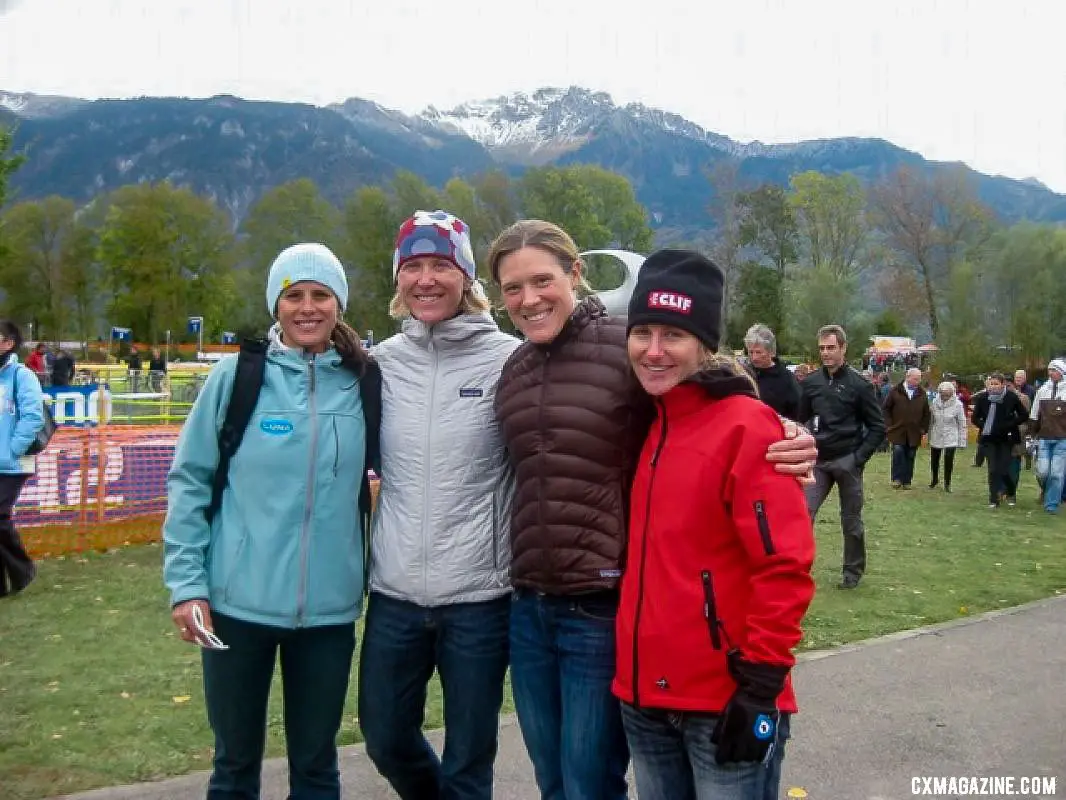
Katerina Nash, Sue Butler, Katie Compton and Amy Dombroski were all in the mix in Switzerland in 2011. photo: Sue Butler
The school introduced her to the prosaic reality of being a professional athlete. “You wake up at 6 a.m. every morning, then you go run, then you have breakfast, then you have morning classes, then lunch, then right after lunch you go training again. The afternoon brings you another routine. You go up the mountain and train for a few hours, come down the mountain and stretch or do another workout, and then homework, and then bed.”
This routine doesn’t leave a lot of time for all things that high school is famous for—irresponsibility, youthful misconduct, adolescent decadence—Amy shrugged this off.
Vic escorted two plates of blood sausage and baked apple to the table, along with a platter of béarnaise mashed potato, risotto and steamed vegetables. As he placed my plate before me, Vic asked “Do you like blood sausage? Hmmm? You have to eat it. Have to.”
“If you ever stay here again, Vic will make lobster for you.” It was hard to avoid the impression that this was a practiced routine.
“I ask her every day. I say, ‘Amy if you want lobster, I’ll make you lobster. Do you want a lobster?’” At this point Vic draped his dishcloth over his wrist like a waiter, pursed his finger together and kissed them in the universal gesture for ‘this is delicious.’ “I’ll put them in the boiling pot, and they’ll make the little noises, it’s ok. And in the water I’ll put vegetables, a little white wine, 10 to 12 minutes, it depends…” Vic starts to mime the actions of cooking his lobsters, “Throw in some eggs to boil there, and prepare a mayonnaise, a salad, and that is the meal.”
And then, squaring up his shoulders and holding a finger to me, “But this is only if you write a nice article about my Amy. Say one word negative and I’ll…” With this, he departed for the kitchen. I tried to share Amy’s enjoyment of this, but I also knew that Vic’s joke came from an earnest and deeply held protective instinct. There was no imaginable world in which I would choose to test this.
How does someone get from Burke Mountain Academy to the Belgian heartlands? Is the U.S. race scene not big enough or tough enough? “I think the American race scene is amazing. It has its own thing going on, it’s own way of racing, spectating, cheering, heckling, and it shouldn’t change that.” But?
“But they say Belgium is the motherland of ’cross, and it really is. It’s much more of a job here. You get up and train and race, and everyone races the same races, week after week, year after year.”
“And then there is the travel—I don’t have the U.S. thing of getting on a plane every weekend, and getting sick every week because I got on a flight straight after a race, then flying to Europe for two World Cups, and the jet lag. Oh! The jet lag!” I couldn’t articulate it at the time, but the irony of needing to travel a couple of thousand miles just to allow yourself to be in the same place is readily apparent.
All this seems worth it, to me, when Amy describes the warm-up lap of Koksijde. She almost launches herself from the chair, noticeably quickens her words and follows every major piece of description with a rap of her hand on the dining table. “Right, so here’s the thing,” rap, “60,000 people,” rap, “All of them there because they love ‘cross, and making so much noise that you can hear it as you ride from the van to the course,” rap, “And I did my recon lap with my heart pegged at…” double rap, “Well, I won’t tell you. But it was high, and I wasn’t even going that hard. That noise,” rap, “It made the air feel different. And the whole time I was there I was aware of being there, in the moment. I felt very alive.”
I asked the obvious question. “Yes. That’s why I do it.” Is there a point when it doesn’t become worth it? The sound of 60,000 fans might make the air tingle, but it doesn’t pay the bills. The response, on the page, might seem defensive or an attempt at self-validation, but I promise that if you had heard Amy’s urgent tone you wouldn’t doubt its sincerity. “I’m trying to be the best cyclist I can be so when I’m no longer racing I can still stay in this world. When this isn’t fun anymore I’ll need to find something else to do, but I know it will be something with a bike.”
“I do love this lifestyle.” A long pause followed. “I’m living out of a suitcase for six months a year.”
Your moment of Zen: If a tree falls in the forest and no one is around to hear it, does it make a sound?
A garbled version of this more befitting Cyclocross Magazine: If a women’s World Cup race happens in a Dutch wood and no one is around to watch it, does Marianne Vos win?
Although there have been some notable additions to the women’s calendar, it remains that women’s races are often put on despite their commercial revenues, not because of their commercial potential.
Now, if a women’s race happens because a series promoter decides it would be good PR, or because the UCI mandates it in the name of equality, this is undeniably A Good Thing. I am at pains to point out that Amy believes this too, and declaimed her love of the Belgian ’cross scene. “Racing every week, at this level, is something I am still getting used to. I still feel like walking around after a race to shake hands and say, ‘Thank you, this is awesome.’” However, if a women’s race happens without the adjoining fanfare of TV coverage, dedicated and detailed reporting, photography, and half-cut fans, what is the point?
In the case of women’s ’cross, we often don’t even have a chance to build the smallest of narratives around their racing. There is almost no mainstream broadcast of races—if you want to watch a full hour of women’s racing, and are the type inclined to endure scratchy and often-dropped streams of these races, then there are at most 15 opportunities to do so in a season. The stupidity of this situation is compounded by the fact that many untelevised women’s races happen an hour before televised men’s races.
As polemical as this is all starting to sound, bear in mind that, at this very moment, we are witnessing the dismantling of established cycling institutions—e.g., Rabobank’s self-extrication from the sport, destabilizing of the UCI’s power base, Europe’s displacement as the be-all and end-all of world-class racing—and the establishment of new ones. It feels like a great moment to allow people to see women’s ’cross, should they want to.
Amy Dombroski thinks so. “I wish we had 20 more minutes, it would change everything. The men get six or nine laps, so you see a tactical race. We get half that, so we don’t have an opportunity to make up for our mistakes.” Women’s racing would be more fun to watch if there was more of it? “Absolutely! You’d see better chases, you’d see team tactics; you’d see drama. Let’s watch someone putting in a huge effort to make up for their mistakes.” [Ed. note: the UCI would grant women an extra 10 minutes starting in 2021]
I invited Amy to complete a little thought experiment. The previous World Cup was in Rome, where Katie Compton effectively lead out Marianne Vos for the last few laps only to be beaten by a good 24 seconds. Amy finished a further 2:30 back in 16th place. What difference to her race would an extra two laps have made? “Well, I was going backwards in Rome…”
It has nearly become a necessity at the press conferences of top-level women’s ’cross events for a journalist to ask Marianne Vos, “What would it take to beat you?” This happened in Hoogerheide, and again at the Louisville World Championships a few weeks later.
Both times Marianne Vos answered with “ride faster than me.” This kind of unflinching literalism is funny and disarming, but it ignores all kinds of un-glamorous but essential factors of her success. Marianne Vos, to be sure, is a once-in-a-generation talent. But she’s also a once in a generation talent that received a once-in-a-generation level of investment and training, and happened to reside in a country that ranks amongst the best for gender equality. To beat Vos, you will definitely need to ride faster than her, but to ride faster than her you’ll need a comparable environment in which to develop your talent.
I put all this to Amy, and asked her what will happen when Marianne Vos quits cyclocross. Will the scant number of sponsors become scanter? Will there be fewer races? Fewer Pros?
In true Zen fashion, she answered my question with a question: “What will happen to cyclocross when Sven Nys retires?” Amy isn’t alone in positing this—if you’ve witnessed the weekly Sven-fest that is the Belgian ’cross scene. So much of the sport’s popularity, which is arguably at an all-time high, is based on the life and times of one man.
The rays of that particular spotlight don’t tend to get as far as women’s racing. “Kevin Pauwels’ Grandma gets more TV coverage than us.”
Thoughts of beating Vos remain, for Amy at least, in the school of incredibly naïve positivism. “I know I have a few years with Telenet-Fidea, and that safety is priceless. I know, right now, that I have what it takes to finish top 10 in a World Cup. But what about top five, next year, when I know a bit more? What about winning one?”
“In two weeks, after Worlds…” Vic interrupted her, “When you are World Champion.” The ever-present twinkle in his eyes hid a more serious point: anything could happen. “We’ll be drinking and wearing the Rainbow Stripes.” He paused. “Top ten, she’ll make the top ten.”
“Yeah. Outside of that, I’ll be disappointed.”
Amy finished 11th in Louisville.
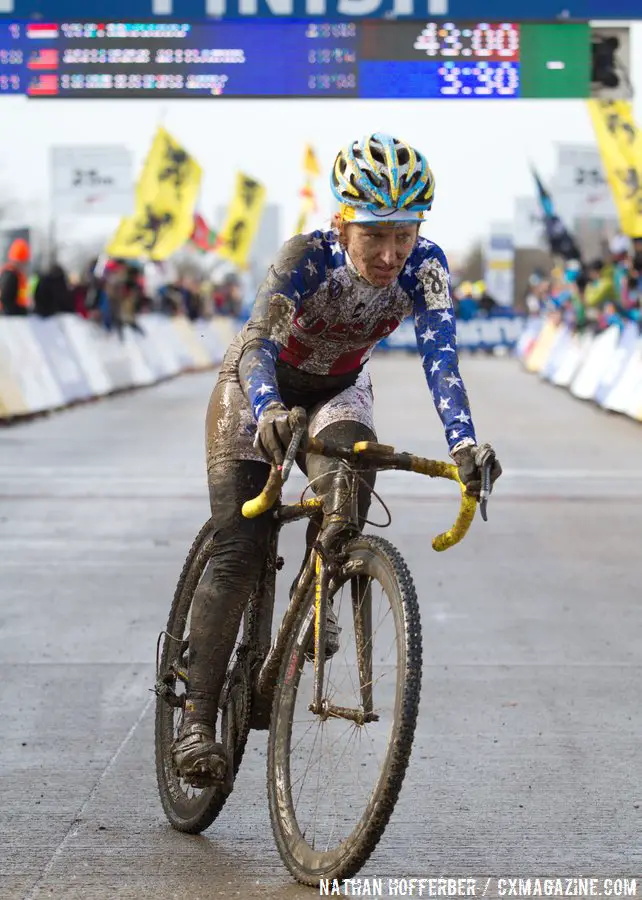
Amy Dombroski post-race at the 2013 World Championships in Louisville. © Nathan Hofferber / Cyclocross Magazine
The morning of the race, Amy showed me her shin wound, the cause of the previous night’s garlic—the sight of it made me want bed rest. I couldn’t imagine racing with it. Emil had cleaned his car in honor of the day, and the weather thanked him with a coating of a grey, sludge-like snow that fell, if not quite horizontally, at an angle sharp enough to fill your eardrum.
Mathematically speaking, there must be a finite number of ways to pronounce Hoogerheide—I heard enough variations to make me doubt this. It was so cold that the racers ran on the spot whenever they weren’t riding anywhere, and when they did move somewhere their semi-regular face-plants highlighted the human comedy of bicycle racing.
I was taken down to the start/finish zone for the start of the race. Emil’s last few breaths of advice were met with, “Yeah, yeah, yeah,” from Amy as she made the final ritualistic pre-race checks, and my half-chewed words of encouragement received a half-smile and raised eyebrows. The message was clear: the support was gratefully taken, but there was only one person on the bike: a 25-year-old from Vermont with painted nails.
Emil advised me to stick close to him for the race, as he knew all the best spots for spectating and the quickest routes between them. We repeatedly marched between the woods and two straights, I shouted blindly at Amy while Emil crafted individual messages of encouragement for each rider he knew personally, which seemed to be everyone.
Amy’s race was not one for the ages. She was visibly faster up the short inclines than anyone around her, and was the only one to find a line on the precipitous descent that the men would later use en masse, but lost time to crashes and the raw power of bigger riders. Emil said it wasn’t anything that couldn’t be remedied by more motorpacing, that Vic would be proud of how quickly she remounted each time she found herself on the ice, and that it was good practice for the expected conditions in Louisville. She finished 20th, a couple of minutes off the pace.
After half an hour of post-race self-flagellation, Amy said the exact same thing. “The more mistakes I make this year, the less I’ll make next year, right?”
If any of the above doesn’t seem that strange or magical to you, think on this: if the situation was entirely reversed, and competing at the highest level of men’s cyclocross meant relying on the generosity and savoir-faire of two old Belgian ladies, wouldn’t that be both strange and a bit magical?
Amy D. and her legacy live on and ride on. Check out our profile of one of her bikes that was raced at the 2018 Louisville Cyclocross National Championships, and see how her name and foundation continue to impact the cyclocross community here.














